The Kei School of Sculpture Occurs During Which Period of Japanese Art History?
![]() BUSSHI 仏師 OF JAPAN = SCULPTORS OF Japan
BUSSHI 仏師 OF JAPAN = SCULPTORS OF Japan
Who Fabricated Japan's Buddha Statues?
Sculptors, Schools & Workshops
in Japanese Buddhist Statuary
![]()
Keiha, Zenpa, Jōkei, Others
Before starting, please run across the Busshi Index. Information technology provides an overview of Nippon's main sculptors (Busshi) and sculpting styles, a helpful A-to-Z Busshi Index, plus definitions for essential terms and concepts. This section of our site includes 14 pages, covers 100+ sculptors, features 100+ photos, and provides the web'due south first-ever integrated guidebook to Japan's sculptors. Besides see From Court to Commoner Buddhism.
Who'due south Here?
Chōkai (Chokai) 長快
Eikai 栄快
Gyōkai (Gyokai) 行快
Inkō 院康
Jōchō (Jocho) 定朝
Jōkaku (Jokaku) 定覚
Jōkei 1 (Jokei) 定慶
Jōkei 2 (Jokei) 定慶
Kaikei 快慶
Kakujo 覚助
Kankei 覚慶
Keishun 慶俊
Kōben (Koben) 康弁
Kōchō (Kocho) 康朝
Kōen (Koen) 康円
Kōjo (Kojo) 康助
Kōkei (Kokei) 康慶
Who'southward Here?
Kōsei (Kosei) 康清
Kōsei (Kosei) 康成
Kōshō (Kosho) 康勝
Kōshun (Koshun) 康俊
Kōun (Koun) 康運
Kōyo (Koyo) 康誉
Kōyū (Koyu) 幸有
Raijo 頼助
Seichō (Seicho) 成朝
Tankei 湛慶
Unga 運賀
Unjo 運助
Unkei 運慶
Zen'en 善円
Zenkei 善慶
Zenshun 善春
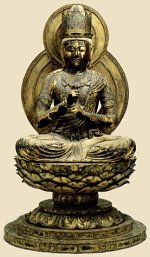
By Unkei 運慶
His primeval extant work.
Dated +1176.
Enjōji Temple, Nara
The Kamakura menses rearranged the landscape and gave nascency to Buddhism for the commoner. In the political realm, decades of social unrest culminated in the victory of Minamoto Yoritomo 源頼朝 (+1147-1199) and his institution of the Kamakura Shōgunate (Shogunate) or Bakufu 幕府 in Kamakura city, far n of Kyōto 京都. The emperor and the royal court remained in Kyoto, symbols of civilization and art, simply political authorization shifted to the Shōgun 将軍 (Shogun) and armed services course (samurai 侍) and remained there for the next vii centuries. In the religious realm, nosotros see the spread of Buddhism amidst the illiterate commoner and a new spirit of realism in religious imagery. The flow gave birth to new and reformed Buddhist movements -- Pure State, Zen, and Nichiren -- devoted to the conservancy of the common people. These schools stressed pure and unproblematic religion over complicated rites and doctrines. Prior to this, Buddhism was largely the faith of the royal courtroom, upper classes, and monastic orders.
Simplicity and frugality became the watchwords of the new military class, replacing the perfumed embroidery of the court and the intellectual elitism of the entrenched monasteries. Faith brutal naturally under the same leveling impulse, as did secular art. The new Kamakura government was anxious to rebuild and reunite, and threw its back up behind the Keiha School 慶派 (based in Nara), whose heroic and powerful Buddhist statuary amend suited the feudal tastes of the war machine overlords. Some other school of sculpture, known every bit Zenpa 善派, appeared during the Kamakura catamenia likewise, merely it was substantially an offshoot of the Kei school and today its artists are classified every bit part of the Kei tradition. Sculpture from this menstruum was also influenced by the artistic styles of Song-dynasty China, particularly in external features like elaborate hair topknots, long fingernails, applied jewelry, and wavy drapery. Portrait sculpture and portrait painting of prominent monks and people were as well innovations of this catamenia, with the Zen sect in particular pursuing this form of expression. Some other innovation of the menstruum was to portray various deities in the nude (e.yard. Benzaiten, Jizō).
![]()
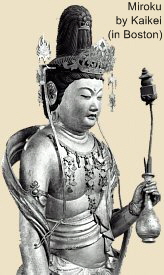
Kamakura Era30+ Busshi of
the Kei School
presented below
The Keiha school dominated Japanese Buddhist statuary in the 13th and 14th centuries (Kamakura Menses, +1183 - 1332), and continued to influence bronze well into the Edo flow 江戸 (+1615 - 1868). Chosen the KEI schoolhouse, for virtually of its artists used the character KEI 慶 in their names. The term HA 派 literally means school or group. Like the powerful Enpa 円派 and Inpa 院派 schools based in Kyoto, the Kei school traced its lineage (see below nautical chart) dorsum to the famous Heian-era sculptor Jocho (Jōchō) 定朝. The Kei schoolhouse is also known as the Nara Busshi 奈良仏師 or Nantō Busshi 南東仏師 (run across Glossary for details) considering their principal workshop was located at Kofukuji (Kōfukuji) Temple 興福寺 in Nara. Yet, they also ran workshops in Kyoto (Kyōto 京都) and the outlying provinces (encounter Kei Workshops). There are several reasons for the Keiha's ascent to prominence in the Kamakura period.
- Kei artists did non enjoy strong connections with the Kyoto purple court, who instead supported the Enpa and Inpa schools based in Kyoto. The Kyoto schools carved pieces of keen delicacy, refinement, and elegance, which were favored by the Kyoto court and aristocracy. The Kei school's lack of shut imperial ties appealed to the new military government in Kamakura, which scorned aristocratic tastes and was broken-hearted to eliminate court influence and court meddling in land diplomacy.
- The Keiha's sculpture embodied a new sense of ability, dynamism, and realism, one that assorted with the refined sculptural styles of the Enpa 円派 and Inpa 院派 schools from Kyoto. This too appealed to the new war machine government in Kamakura, as did the Keiha's strong agreement and reinterpretation of the classical styles of the earlier Nara and Heian periods. The work of Nara's Kei artists was often labeled as "crude" past their rivals in Kyoto, highlighting the deviation in their styles.
-

 Major temples had been damaged during the conflict betwixt the Minamoto (Genji 源氏) and Taira (Heike 平家) clans during the Genpei War 源平合戦 (Genpei Kassen + 1180 to 1185). Once the disharmonize ended (victory going to Minamoto), one of the elevation priorities was to rebuild and repair Nippon's important religious structures. The most prestigious reconstruction projects were undertaken at Kofukuji (Kōfukuji) Temple 興福寺 and Todaiji (Tōdaiji) Temple 東大寺, both in Nara and both burnt to the ground by Taira Shigehira 平重衡 in +1180. Not surprisingly, the Kamakura Shogunate (Shōgunate, Bakufu 幕府) awarded these commissions to the Kei schoolhouse, the so-called Nara Busshi based in Nara. The success of the Keiha school in remaking the bronze of these two important temples spearheaded its ascension as the dominant force in Japanese Buddhist statuary, with both the Enpa 円派 and Inpa 院派 schools suffering meaning declines in importance thereafter (essentially, the Kyoto schools were forced to incorporate the popular Kei mode in their statuary, and thus in the subsequent catamenia were enveloped by the Kei schoolhouse). Kei artists also fix workshops in outlying provinces and played a major function in creating statuary for the new military capital in Kamakura. The most acclaimed Kei artist was Unkei 運慶 (d. 1223). Some other acclaimed Kei sculptor was Kaikei 快慶, who besides sprang from the workshop of Kokei (Kōkei) 康慶, who was Unkei's father. But Kaikei was not related past blood -- he was a brilliant apprentice to Unkei's father. All three worked together on diverse projects, with Unkei and Kaikei commonly considered the all-time Kei sculptors of the age.
Major temples had been damaged during the conflict betwixt the Minamoto (Genji 源氏) and Taira (Heike 平家) clans during the Genpei War 源平合戦 (Genpei Kassen + 1180 to 1185). Once the disharmonize ended (victory going to Minamoto), one of the elevation priorities was to rebuild and repair Nippon's important religious structures. The most prestigious reconstruction projects were undertaken at Kofukuji (Kōfukuji) Temple 興福寺 and Todaiji (Tōdaiji) Temple 東大寺, both in Nara and both burnt to the ground by Taira Shigehira 平重衡 in +1180. Not surprisingly, the Kamakura Shogunate (Shōgunate, Bakufu 幕府) awarded these commissions to the Kei schoolhouse, the so-called Nara Busshi based in Nara. The success of the Keiha school in remaking the bronze of these two important temples spearheaded its ascension as the dominant force in Japanese Buddhist statuary, with both the Enpa 円派 and Inpa 院派 schools suffering meaning declines in importance thereafter (essentially, the Kyoto schools were forced to incorporate the popular Kei mode in their statuary, and thus in the subsequent catamenia were enveloped by the Kei schoolhouse). Kei artists also fix workshops in outlying provinces and played a major function in creating statuary for the new military capital in Kamakura. The most acclaimed Kei artist was Unkei 運慶 (d. 1223). Some other acclaimed Kei sculptor was Kaikei 快慶, who besides sprang from the workshop of Kokei (Kōkei) 康慶, who was Unkei's father. But Kaikei was not related past blood -- he was a brilliant apprentice to Unkei's father. All three worked together on diverse projects, with Unkei and Kaikei commonly considered the all-time Kei sculptors of the age.
![]()
Major KEIHA Workshops. Their master workshops were at Shichijō Bussho in Kyoto, too as at their headquarters in Nara's Kōfukuji (Kofukuji) Temple 興福寺. They also set workshops in the outlying provinces. The Keiha flourished in the 13th and 14th centuries attributable to the strong patronage of the military government in Kamakura. Over time, the Shichijō Bussho expanded to three chief workshops:
- Shichijō Naka Bussho 七条中仏所; established in the 13th century by Kōben 康弁, Unkei'south 3rd son.
- Shichijō Higashi Bussho 七条東仏所; established in the 14th century past Kōshun 康俊, son of Unjo 運助, grandson of Unkei.
- Shichijō Nishi Bussho 七条西仏所; established by Unkei'due south 5th-generation descendant Kōyo 康誉 in the 14th century.
- In the belatedly 14th century, the sculptor Kankei 覚慶 split from the Keiha to form an independent guild called Tsubai Bussho 椿井仏所.
- The term Shichijō Bussho 七条仏所 is occasionally used as a general term to refer to the Keiha school. The headquarters of the Kei school was at Kōfukuji Temple 興福寺 in Nara. It was founded by Raijo in the early 11th century. But before then, the principal workshop was located in Kyoto's Shichijō Takakura 七条高倉 area, founded by Jōchō'southward 定朝 son Kakujo 覚助 (d. +1077).
![]()
KEIHA SCHOOL (NARA BUSSHI)
From Jōchō to Unkei'south Sons
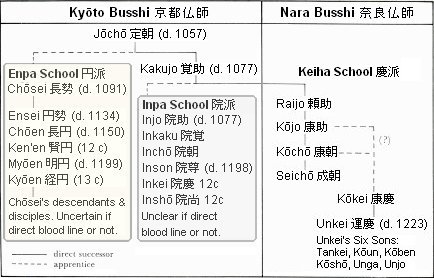
![]()
Annotation: The above nautical chart is based in part on one appearing in Mori Hisashi's book Sculpture of the Kamakura Period (ISBN 0-8348-1017-4). The KEIHA school rose to prominence nether Unkei. Equally for Unkei's male parent, KOKEI, fiddling is known of his lineage. Some call back he was an amateur to either Kōjo or Kōchō.
![]()
Keiha School Busshi. Also see lineage chart higher up and beneath.
- Jōchō 定朝 (d. +1057). Patriarch of Japan'southward three most acclaimed schools of Buddhist statuary -- the Enpa and Inpa schools of Kyoto and the Keiha schoolhouse of Nara. Visit the Jōchō Page and the Heian-Era Busshi Page for more than details and photos.
- Kakujo 覚助 (d. +1077). Son and successor of Jōchō. Kakujo established his Shichijō Bussho 七条仏所 workshop in Kyoto's Shichijō Takakura 七条高倉 area. The workshop remained agile from the late twelfth century into the 19th century, and served as an important workshop for Kei artists. Unkei, the undisputed champion of Kamakura sculpture, moved to Kyoto in the latter half of his life, establishing a workshop in the same area. No extant artwork past Kakujo.
- Raijo 頼助. Son and successor of Kakujo. Raijo was not content in Kyoto, for ii other powerful Busshi groups (the Enpa 円派 and Inpa 院派) had a near-monopoly on statue production and courtroom patronage. These schools all sprang from the workshop of the acclaimed Jōchō, who was Kakujo's begetter and Raijo'southward grandad. Raijo established his workshop at Kōfukuji Temple 興福寺 in Nara, which over time became the chief headquarters of the Keiha Schoolhouse 慶派. Raijo'south decision to move to Nara was a wise one, for he and his lineage quickly gained the support of the influential Fujiwara 藤原 clan located in Nara. Kōfukuji (Kofukuji) Temple, moreover, was the clan temple of the powerful Fujiwara family. During his lifetime, Raijo was awarded Hokkyō (Hokkyo) rank, the third highest title amongst Buddhist sculptors. No extant artwork by Raijo.
- Kōjo 康助 (Kojo). Son of Raijo. Based in Nara. The lack of large-scale projects in Nara during his lifetime required him to accept assignments in Kyoto. No extant artwork.
- Kōchō 康朝 (Kocho). Son of Kōjo. Based in Nara. The lack of large-calibration projects in Nara during his lifetime required him to undertake assignments in Kyoto. No extant artwork.
- Seichō 成朝 (Seicho). Son of Kōchō. Sired no son to succeed him, and is therefore causeless to have died rather immature. In +1181, Seichō presented the imperial court in Kyoto with a genealogy listing of the Nara Busshi, listing six generations -- Jōchō, Kakujo, Raijo, Kōjo, Kōchō, and Seichō. The listing was part of Seichō'due south endeavor to convince the court that the Nara Busshi had starting time rights to remake the statues of Kōfukuji (Kofukuji) Temple 興福寺 and Tōdaiji (Todaiji) Temple 東大寺, both in Nara, both burnt to the ground in +1180 during the Genpei War 源平合戦 (Genpei Kassen). Around +1185, Minamoto Yoritomo 源頼朝 (+1147-1199), the leader of the military government in Kamakura, invited Seichō to Kamakura to make statuary for Shōchōju-in (Shochoju-in) Temple 勝長寿院. The temple no longer exists, just Seichō'southward journey to Kamakura no incertitude helped pave the manner for other Nara Busshi to move to Kamakura and other outlying areas. It is thought that Unkei, the most bright sculptor of the Kamakura period, may have accompanied Seichō on his journey to Kamakura, but this remains unclear. No extant artwork by Seichō.
![]()
Keiha 慶派 (Kei Schoolhouse) in Kamakura Era
Starting with Kōkei, Unkei's Father
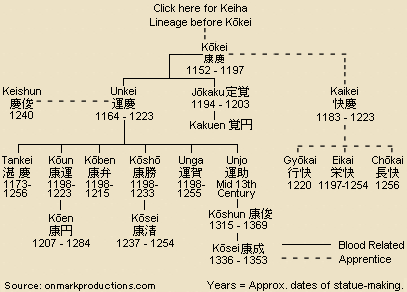
Data from Sculpture of the Kamakura Period (ISBN 0-8348-1017-four)
Also from 日本史小百科 ・彫刻 ・久野健編 ・近藤出版社刊
![]()
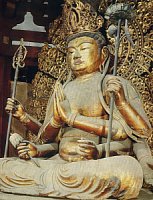
不空羂索観音
Fukūkenjaku Kannon
by Kōkei, dated +1189.
Lacquer & gilded Leafage
over wood, H = 348 cm
Kōfukuji Temple 興福寺, Nara
Photograph: Heibonsha Survey, V11
Father of acclaimed sculptor Unkei. Kōkei was the leader of the Nara Busshi (aka Keiha school) when large-scale restoration work was underway in Nara at Tōdaiji (Todaiji) Temple 東大寺 and at Kōfukuji (Kofukuji) Temple 興福寺. Both temples had been burnt to the ground in +1180 by the Taira 平 clan. Both were amid the 7 Great Nara-Era Temples. But Seichō, the true head of the Nara Busshi, was away working on a projection for the Shōgun Minamoto in Kamakura when restoration efforts began at Tōdaiji. During his absence, Kōkei acted as Seichō'due south substitute main in Nara. Kōkei eventually succeeded Seichō every bit head of the Nara Busshi, only Kōkei, according to near scholars, shared no blood ties with Seichō. Some propose Kōkei was Kōchō'south younger blood brother, while others think he was an apprentice of either Kōchō or Kōjo. The latter ii busshi are one generation older than Kōkei. But evidence is lacking and Kōkei'south genealogy remains a mystery. With the death of Seichō, leadership of the Kei Schoolhouse passed to Kōkei and then to his son Unkei. Near the end of his life (former around +1196), Kōkei transferred his title of Hōgen (Hogen 法眼, lit. middle of the law) to Unkei, his son and successor. Hōgen was the second highest Buddhist rank awarded to artists in those days. Ane of the final records well-nigh Kōkei comes from Tōdaiji Temple, which deputed Kōkei to cleave Gigaku 伎楽 masks for theatrical and ceremonial dances that had been performed at Buddhist temples in Nihon since the 6th century. Gigaku, yet, died out as an art form during the Kamakura era. <Editor's Annotation. Unsure if these masks are extant> See photos in a higher place and below for extant work by Kōkei.
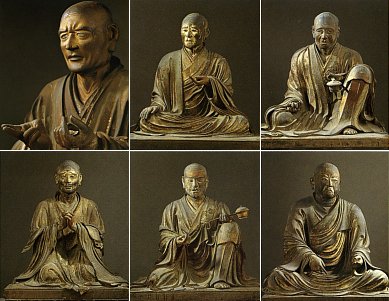
Six Patriarchs of Nihon'southward Hossō School. Carved by Kōkei, father of Unkei.
Colored Wood, Dated +1189, H = 73.3 cm to 84.4 cm
National Treasures at Kōfukuji Temple 興福寺 in Nara. Photo courtesy of temple catalog.
![]()
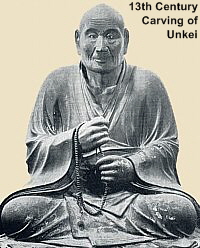
![]() Unkei 運慶 (d. 1223). It is impossible to exaggerate the importance of Unkei to the world of Japanese Buddhist bronze. He is the undisputed champion of Kamakura-era statuary, which featured a new realism, heroic spirit, power and passion, muscular bodies, plump fleshy faces, and virile strength. His life has been well documented. Although many of his works are still extant, most accept been lost. He grew upward during a very turbulent fourth dimension in Japanese history (meet in a higher place Overview of Kamakura Menses), and lived and worked in the three nigh important cities of his age -- Nara, Kyoto, and Kamakura. His efforts to remake and restore the peachy temple treasures of Nara and Kyoto, plus his early exposure to the raw emotions of the Kamakura region and the new military grade (which scorned the aristocratic tastes and indulgences of the Kyoto royal court and nobility) greatly influenced his artwork. He became the most influential artist of his fourth dimension, and today is peradventure the about widely known artist of Buddhist sculpture in Japan. For more details and photos, see the Unkei folio. Too see the lineage chart above.
Unkei 運慶 (d. 1223). It is impossible to exaggerate the importance of Unkei to the world of Japanese Buddhist bronze. He is the undisputed champion of Kamakura-era statuary, which featured a new realism, heroic spirit, power and passion, muscular bodies, plump fleshy faces, and virile strength. His life has been well documented. Although many of his works are still extant, most accept been lost. He grew upward during a very turbulent fourth dimension in Japanese history (meet in a higher place Overview of Kamakura Menses), and lived and worked in the three nigh important cities of his age -- Nara, Kyoto, and Kamakura. His efforts to remake and restore the peachy temple treasures of Nara and Kyoto, plus his early exposure to the raw emotions of the Kamakura region and the new military grade (which scorned the aristocratic tastes and indulgences of the Kyoto royal court and nobility) greatly influenced his artwork. He became the most influential artist of his fourth dimension, and today is peradventure the about widely known artist of Buddhist sculpture in Japan. For more details and photos, see the Unkei folio. Too see the lineage chart above.

UNKEI, SPECIAL Page
FEATURING 24 PHOTOS
![]()
Jōkaku 定覚 (Jokaku). Son of Kōkei 康慶 and Unkei'southward younger brother. Active in belatedly 12th century, early 13th century. Worked on the restoration at Tōdaiji Temple 東大寺 around +1996; worked with Kaikei 快慶 on a Nyoirin Kannon 如意輪観音 statue and responsible for carving a large statue of Tamonten 多聞天. His proper name appears in period records for other projects in Nara and Kyoto. Unfortunately none of those statues has survived. His career as an agile Busshi (+1194-1203) was relatively short. No extant bronze to my knowledge. He had a son named Kakuen 覚円 who became a monk of the Tendai 天台 sect.
![]()

KAIKEI, SPECIAL Page
FEATURING 20+ PHOTOS
![]()
Kaikei'due south Students. Three other important Kei artists sprang from Kaikei'due south workshop, and carried on his Annami-way sculpture. Also see lineage chart in a higher place.
- Gyōkai 行快 (Gyokai). Active in starting time-half of the 13th century. Senior apprentice of Kaikei. Awarded Hōgen rank. Two extant works: (1) Shaka Nyorai 釈迦如来 at Daihō-on-ji Senbon Shakadō 大報恩寺・千本釈迦堂 and (2) one smaller statue of the Senju (1000-Armed ) Kannon 千手観音 at Sanjūsangendō. However, the Shaka statue is probably a reproduction, as the original was reportedly damaged or destroyed in earlier centuries.
- Eikai 栄快. Apprentice to Kaikei. Active in mid-13th century.
- Chōkai 長快 (Chokai). Apprentice to Kaikei. Active in mid-13th century.
| | |
| Shaka Nyorai 釈迦如来 | Kōbō Daishi 弘法大師 |
| |
![]()
UNKEI'Southward SIX SONS: All 6 pursued careers as Busshi (Buddhist sculptors). Work by Tankei, Kōben, and Kōshō is still extant. Unkei had many other apprentices besides his sons, plus other important artists who are categorized equally Keiha artists. They are presented beneath as well. For lineage, delight see the to a higher place lineage chart.
- Tankei 湛慶 -- 1st son, details below)
- Kōun (Koun) 康運 -- 2nd son, details below)
- Kōben (Koben) 康弁 -- 3rd son, details below)
- Kōshō (Kosho) 康勝 -- 4th son, details beneath)
- Unga 運賀 -- 5th son, details below)
- Unjo 運助 -- sixth son, details beneath)
- Unkei'south Other Descendants (details below)
- Keishun (apprentice; details below)
- Jōkei (Jokei) #one 定慶 (Kei school; details beneath)
- Jōkei (Jokei) #2 定慶 (Kei schoolhouse; details beneath)
- Kōyū (Koyu) 幸有 (details beneath)
- Zen'en 善円, Zenkei 善慶, Zenshun 善春 (details below)
TANKEI 湛慶 (+1173-1256). Unkei'south eldest son and main amateur. An acclaimed sculptor of the ascendant Keiha schoolhouse during the Kamakura flow, whose workshop was located in the Shichijō Commune 七条仏所 of Kyoto. During his long career (he died when 83), he was honored with the peak three ranks available to Buddhist sculptors (Hō-in 法印, Hōgen 法眼, and Hokkyō 法橋). He helped to restore the statuary at Tōdaiji Temple 東大寺 and Kōfukuji Temple 興福寺, but is peradventure best remembered for the major office he played in remaking the statuary for Rengeōin (Renge-o-in) Temple 蓮華王院, a Tendai-sect temple in Kyoto, which was destroyed in a burn in +1249. More commonly known every bit Sanjūsangendō (Sanjusangendo) 三十三間堂, this temple contains ane,001 figures of the Senju (i,000-Armed) Kannon 千手観音. The central effigy of the seated Senju Kannon was carved by Tankei (come across below photos), every bit well as nine other smaller extant versions of the deity. Tankei was 81 years old when the fundamental Kannon statue was completed in +1254, and was assisted past two nephews -- Kōen 康円 (son of Kōun) and Kōsei 康清 (son of Kōshō). Other extant work by Tankei includes statues of Bishamonten 毘沙門天 flanked by two attendants (Kyōji 脇侍) at Sekkeiji Temple 雪蹊寺 in Kochi Prefecture, and statues of Zemmyōshin 善妙女神 and Byakkōshin 白光神 attributed to Tankei at Kōzanji Temple 高山寺 northwest of Kyoto. Tankei's statuary is noted for its understated, gentle, and refined realism, a suppression of busy details, and plump faces.
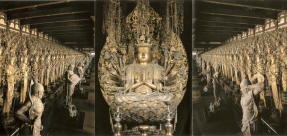
Seated Senju (1000-Armed) Kannon 千手観音座像 (in center)
12th Century, Photo from Sanjūsangendō 三十三間堂 Brochure
Carved by Tankei (Unkei's son)
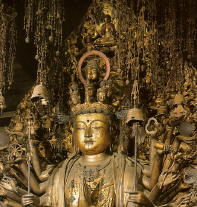
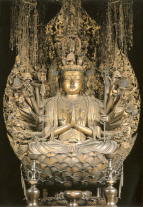
(Fifty) Senju (1000-Armed) Kannon 千手観音 by Tankei
12th Century, Photos Courtesy Sanjūsangendō Brochure
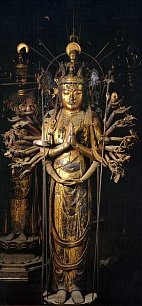
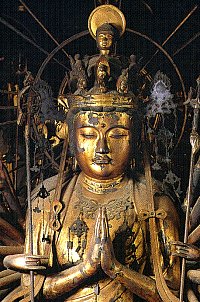
Smaller Senju (g-Armed) Kannon by Tankei, 12th Century
Sanjūsangendō in Kyoto, dated +1254, wood with gold leaf.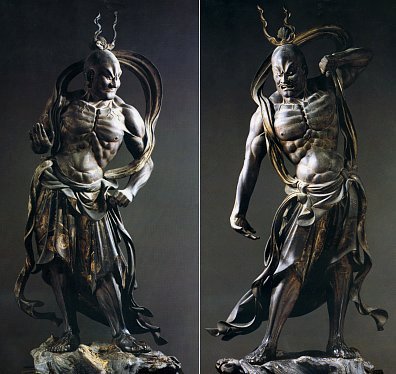
Niō 仁王 Guardians, attributed to Tankei or to his supervision.
At Sanjūsangendō in Kyoto, approx. 165 cm in tiptop. Poly-chromed Woods, Joined Cake Structure
Stunning masterworks of realism, these ii statues are office of a ready chosen the 28 Attendants
(Nijūhachi Bushū 二十八部衆) to Senju Kannon. The prepare at Sanjūsangendō actually contains
xxx statues, of uneven quality, non firmly dated nor attributed. Some scholars believe the best pieces,
including the ii Niō, were made by Tankei or made under Tankei'southward supervision.
![]()
Kōun 康運 (Koun). Unkei's second son, active sculptor betwixt +1198-1223. No known extant artwork. However, Kōun's son Kōen 康円 was one of the near active sculptors of the Keiha school in the Kamakura period, ultimately becoming the successor of his uncle Tankei. See Kōen below. As well, some advise that Kōun worked under an assumed name (pseudonym), and that the acclaimed Kamakura-era sculptor Jōkei I is in fact none other than Kōun. This has never been proven <source Mori Hisashi, p.91>
![]()
Kōben 康弁 (Koben). Unkei's third son. Active between +1198-1215. Established his ain worship -- Shichijō Naka Bussho 七条中仏所 -- in Kyoto's Shichijō district in the early 13th century. Ii of his statues are extant. They are the Ryūtōki Ryūzō (Ryutoki Ryuzo) 竜燈鬼立像, a pair of demons-goblins dated to +1215 and located at Kōfukuji Temple 興福寺 in Nara. One is called Tentōki (Tentoki ) 天燈鬼 and the other Ryūtōki (Ryutoki) 龍燈鬼. <Some scholars, however, believe the Tentōki goblin was made past a different busshi. Source: Mori> Also see Four Heavenly Kings, who are about always depicted standing atop similar demons called the Jyaki.
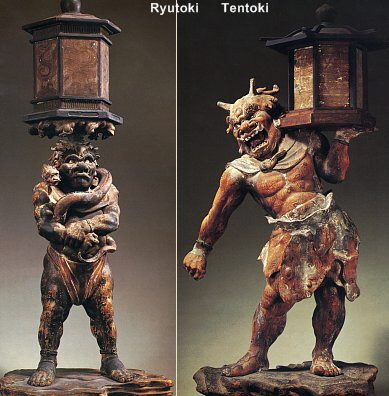
Ryūtōki Ryūzō 竜燈鬼立像
Two Jyaki 邪鬼 (goblins) carrying lanterns to light up the road in front of Shaka Nyorai.
Dated +1215, by Kōben, Kōfukuji Temple 興福寺, Nara. Painted wood. Japanese Cypress.
L: Ryutoki (Ryūtōki 龍燈鬼), H = 77.8 cm R: Tentoki (Tentōki 天燈鬼), H = 78.2 cm
Inset Crystal Optics (Gyokugan 玉眼), Joined-Block Technique (寄木造)See Offerings of Light for details on lanterns.
![]()
Kōshō 康勝 (Kosho) . Unkei's fourth son. Active betwixt +1198-1233. Kōshō's son Kōsei was also an active sculptor. Around +1198, Kōshō worked together with his begetter Unkei and his two brothers Tankei and Kōben on restoring the Niō-Niten 仁王・二天 statues at Tōji Temple 東寺 in Kyoto, and in +1208 he worked on the restoration of the Kōmokuten 広目天 statue at Kōfukuji Temple 興福寺 in Nara. Extant statues by Kōshō include:
- Seated Amida Buddha 阿弥陀如来 at Hōryūji Temple 法隆寺 in Nara. Dated +1232. H = 64.half-dozen cm. Bronze.
- Portrait statue of Kūkai 空海 (Kōbō Daishi 弘法大師) at Tōji Temple 東寺 in Kyoto. 13th Century. Wood.
-
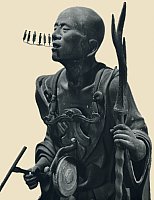
Monk Kuya 空也, H = 117.5 cm
Painted wood. Past Kōsho.
13th century, at Roku
Haramitsuji 六波羅密寺, Kyoto Portrait statue of Kūya 空也 (Kuya) at Roku Haramitsuji 六波羅密寺 in Kyoto. The temple is also known as Saikōji 西光寺. Kūya (+903-972) or Kūya Shūnin 空也上人 was a famous 10th-century Japanese monk who gained the monikers "Sage of the People" (Ichi no Hijiri 市聖) and "Sage of Amida" (Amida Hijiri 阿弥陀聖), for he walked amidst the mutual folk preaching simple organized religion in Amida Buddha while praying constantly to Amida for their salvation. During his many years of traveling effectually the countryside, he skillful a course of chanting that employed song and dance (odorinenbutsu 踊念仏). In this realistic portrait sculpture, there are six miniature Amida images flowing out of his mouth -- they represent his prayers, specifically the chanting of the half dozen-grapheme devotional nenbutsu 念仏 to Amida (Namu Amidabutsu 南無阿弥陀仏). Unproblematic facial features, dressed in peasant's garb with wrinkled habiliment, wearing straw sandals, holding a stick to beat his gong for the odorinenbutsu, with actual veins fifty-fifty visable. The 6 characters of Amida'south nenbutsu symbolize the half dozen states of karmic rebirth.
Portrait statue of Kūya 空也 (Kuya) at Roku Haramitsuji 六波羅密寺 in Kyoto. The temple is also known as Saikōji 西光寺. Kūya (+903-972) or Kūya Shūnin 空也上人 was a famous 10th-century Japanese monk who gained the monikers "Sage of the People" (Ichi no Hijiri 市聖) and "Sage of Amida" (Amida Hijiri 阿弥陀聖), for he walked amidst the mutual folk preaching simple organized religion in Amida Buddha while praying constantly to Amida for their salvation. During his many years of traveling effectually the countryside, he skillful a course of chanting that employed song and dance (odorinenbutsu 踊念仏). In this realistic portrait sculpture, there are six miniature Amida images flowing out of his mouth -- they represent his prayers, specifically the chanting of the half dozen-grapheme devotional nenbutsu 念仏 to Amida (Namu Amidabutsu 南無阿弥陀仏). Unproblematic facial features, dressed in peasant's garb with wrinkled habiliment, wearing straw sandals, holding a stick to beat his gong for the odorinenbutsu, with actual veins fifty-fifty visable. The 6 characters of Amida'south nenbutsu symbolize the half dozen states of karmic rebirth. - Kōshō is also attributed with making the four wooden statues of the Shitennō 四天王 at Enjōji (Enjoji) Temple 円成寺 in Nara Prefecture.
![]()
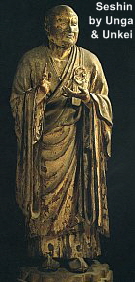
 Unga 運賀 Unkei'south fifth son. Agile between +1198-1255. During his lifetime he gained the rank of Hokkyō, the 3rd highest title awarded to sculptors. Although no work by Unga has survived, one tin still assume his work closely followed the realistic way of his acclaimed father, Unkei.
Unga 運賀 Unkei'south fifth son. Agile between +1198-1255. During his lifetime he gained the rank of Hokkyō, the 3rd highest title awarded to sculptors. Although no work by Unga has survived, one tin still assume his work closely followed the realistic way of his acclaimed father, Unkei.
In fact, the statue of Seshin Bosatsu 世親菩薩 at Kōfukuji Temple 興福寺 in Nara, fabricated under the supervision of Unkei or sometimes attributed to Unkei, was actually carved past Unga (co-ordinate to temple inscriptions). Nine statues in total were carved for the temple between +1208-1212, with Unkei directing 10 busshi and numerous other minor busshi. Just three of the nine statues are extant, and each was plain carved by a dissimilar busshi. But Unkei did non allow the personalities of the sculptors to surface in the statues, and the style that predominates in all three is vintage Unkei, and thus the statues are attributed to Unkei and his supervision.
![]()
Unjo 運助 . Unkei's 6th son. Agile in first half of 13th century. No extant work by Unjo. His son Kōshun 康俊 established a workshop in Kyoto in the 14th century, from which Kōshun and his son Kōsei 康成 flourished.
![]()
UNKEI'Southward GRANDSON
Kōen 康円 (Koen). Koen (+1207-1284). Grandson of Unkei 運慶. Son of Kōun 康運. Successor to Tankei 湛慶 (Kōun's brother). Kōen was a renowned sculptor of the Keiha schoolhouse during the late Kamakura menses. Many of his pieces are all the same extant. He was awarded Hōgen 法眼 rank in his career.
- Appentice to his uncle Tankei 湛慶 during the restoration of the bronze at Sanjūsangendō (Rengeōin Temple 蓮華王院) in Kyoto between +1251-1254. Post-obit Tankei'due south decease in +1256, Kōen became a chief busshi. Six of the smaller Senju (1000-Armed) Kannon statues at Sanjūsangendō are attributed to Koen.
- Taisan'ō 太山王 (one of the X Kings of Buddhism), Shirokuzō 司録像, and Shimeizō 司命像 (all fabricated around +1259) at Byakugōji Temple 白毫寺 in Nara.
- Followers of the Iv Angelic Guardians (Shitennō Kenzoku 四天王眷属) along with Follower of Tamonten 多聞天 (now at Atami Art Museum, Shizuoka Prefecture, Nihon). Made in +1267.
- Fudō Myō-ō 不動明王 and Fudō's Viii Attendants (Fudō Hachi Dai Dōji 八大童子) at Kannonji Temple 観音寺 in Tokyo; fabricated in +1272.
- Monju Bosatsu 文殊菩薩 and Four Attendants (Monju Gosonzō 文殊五尊像) in the Nakamura Collection in Tokyo. Made in +1273.
- Aizen Myō-ō 愛染明王 at Jingo-ji Temple 神護寺 in Kyoto. Made in +1275.
![]()
UNKEI'South GRANDSON
Kōsei 康清 (Kosei). Grandson of Unkei 運慶. Son of Kōshō 康勝. Agile +1237-1254. Awarded Hōgen 法眼 rank in his career.
- Appentice to his uncle Tankei 湛慶 during the restoration of the statuary at Sanjūsangendō (Rengeōin Temple 蓮華王院) in Kyoto between +1251-1254.
- Jizō Bosatsu 地蔵菩薩 at Tōdaiji Temple 東大寺 in Nara, within the Nembutsudō 念仏堂 (Invocation Hall) defended to the soul of his granddaddy Unkei, his father Kōshō, and others.
![]()
UNKEI'Due south GRANDSON
Kōshun 康俊 (Koshun). Grandson of Unkei. Son of Unjo 運助. Active first half 14th century. Many extant works. Both Kōshun and his son Kōsei considered themselves as Nara Busshi, attached to the Kōfukuji Temple 興福寺 in Nara, but their work extended far to the south into Kyushu. Kōshun in fact established his own branch workshop in Kyoto named Shichijō Higashi Bussho 七条東仏所.
- Jizō Bosatsu 地蔵菩薩 at Hōkōin Temple 宝光院 in Nara Prefecture. Dated +1315.
- Shōtoku Taishi 聖徳太子 at Atami Art Museum, made +1320.
- Shitennō 四天王 at Eikōji 永興寺, Oita Prefecture, fabricated +1321-22.
- Monju Bosatsu 文殊菩薩 at Hannya-ji Temple 般若寺, Nara, made +1324
- Fugen Enmei Bosatsu 普賢延命菩薩 at Ryūdenji Temple 龍田寺, Saga Prefecture, made +1326.
- Hachiman 八幡 (Shinto god) as a Buddhist priest, Boston Museum of Fine Arts, made +1328
- Monju Bosatsu 文殊菩薩 and Four Attendants (Monju Gosonzō 文殊五尊像) at Daikōji Temple 大光寺, Miyazaki Prefecture, fabricated in +1348
- Fudō Myō-ō 不動明王 at Fukushōji Temple 福祥寺, Hyōgo Prefecture, made +1369.
![]()
UNKEI'Southward LATER DESCENDANTS
- Kōsei 康成 (Kosei). Great grandson of Unkei. Grandchild of Unjo 運助. Son of Kōshun. Both Kōsei and his father Kōshun considered themselves as Nara Busshi, attached to the Kōfukuji Temple 興福寺 in Nara, but their piece of work extended far to the s into Kyushu.
- Jizō Bosatsu 地蔵菩薩, formerly in Hara Collection (Tokyo), made in +1336.
- Nio (Niō) 仁王 Guardians, Kimpusenji Temple 金峰山寺, Mt. Yoshino 吉野, Nara Prefecture, made in +1338
- Yakushi Nyorai 薬師如来, Kimpusenji Temple 金峰山寺, Mt. Yoshino 吉野, Nara Prefecture, made in +1353.
- Kōyo 康誉 (Koyo). 5th-generation descendant of Unkei and head busshi of Tōji Temple 東寺仏師 in Kyoto. Active in the 14th century. Kōyo's extant statue of Dainichi Nyorai 大日如来 at Henjōji Temple 遍照寺 in Tochigi Prefecture, made in +1346, has a heavy, fleshy body and elaborately carved robes, but fine art historians consider it to exist conventional and rather stiff. Kōyo established an important Keiha branch schoolhouse in Kyoto known as the Shichijō Nishi Bussho 七条西仏所.
- Kankei 覚慶 . In the late 14th century, the sculptor Kankei split from the Keiha to form an independent guild chosen the Tsubai Bussho 椿井仏所, from which sprang numerous sculptors.
![]()
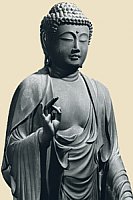 Keishun 慶俊
Keishun 慶俊
Unkei's amateur, unrelated by claret. Active in the starting time half of the 13th century. Keishun hailed from Tajima Province (modern-day Hyōgo Prefecture). During his lifetime he gained the rank of Hokkyō, the third highest championship awarded to sculptors.
Keishun is the sculptor of the extant statue of Amida Nyorai (Buddha) 阿弥陀如来 at Senjūji Temple 千手寺 in Mie Prefecture, made in +1240. The statue is 97.3 centimeters in height, made of wood with applied lacquer and gold leaf. Run into the photo at right.
![]()
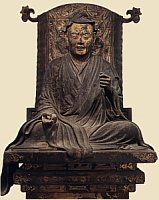
![]() Jōkei 1 定慶 (Jokei). A member of the Kei school, although his lineage is unclear. Active in the tardily 12th and early 13th centuries. Curiously, some other of import sculptor of the period used the same name, so scholars label them as J ōkei i and Jōkei 2. Some theorize that Jōkei one was the apprentice of Kōkei (father of Unkei); others suggest he was Unkei's second son, Kōun, working under an assumed name. Jōkei 1 is credited with creating his own unique style, blending both the realism of the Kei schoolhouse with the creative styles of Sung-dynasty People's republic of china. Extant work includes:
Jōkei 1 定慶 (Jokei). A member of the Kei school, although his lineage is unclear. Active in the tardily 12th and early 13th centuries. Curiously, some other of import sculptor of the period used the same name, so scholars label them as J ōkei i and Jōkei 2. Some theorize that Jōkei one was the apprentice of Kōkei (father of Unkei); others suggest he was Unkei's second son, Kōun, working under an assumed name. Jōkei 1 is credited with creating his own unique style, blending both the realism of the Kei schoolhouse with the creative styles of Sung-dynasty People's republic of china. Extant work includes:
- Sanju 散手 mask (Bugakumen 舞楽面 mask), dated +1184, Kasuga Shrine 春日大社, Nara. The mask is admired for its exceptional realism and plasticity.
- Statue of Indian Buddhist Layman Yuima 維摩, dated +1196, Kōfukuji Temple 興福寺, Nara. Encounter photo below.
- Seated Monju Bosatsu 文殊菩薩, dated +1196, Kōfukuji Temple 興福寺, Nara. See photo below.
- Bonten 梵天, dated +1202, Kōfukuji Temple 興福寺, Nara. Wood, H = 181.3 cm, deeply carved folds in an elegant robe, reflecting the artistic influence of Prc's Song 宋 (Jp. = Sō) dynasty. Encounter photograph below.
- Niō Guardians 仁王, 13th Century, Kōfukuji Temple 興福寺, Nara. The 2 are attributed to Jokei. H = 161.5 cm, painted woods, crystal eyes. See photos below.
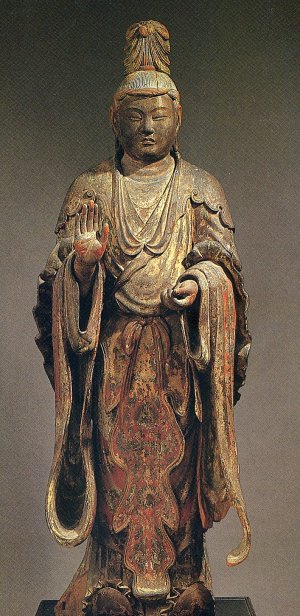
Bonten 梵天, dated +1202, by Jōkei i.
Kōfukuji Temple 興福寺, Nara. Wood, H = 181.3 cm, deeply carved folds & elegant robe.
Reflects artistic influence of China's Song 宋 dynasty. Important Cultural Property.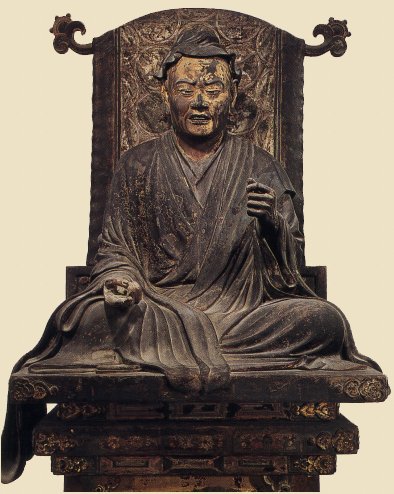
Indian Buddhist Layman Yuima 維摩 past Jōkei 1, National Treasure
Dated +1196, H = 88.v cm, Kōfukuji Temple 興福寺, Nara.
This statue, together with the Monju statue beneath, draw the scene when Monju
was sent by Buddha to visit Yuima, who was sick in bed; the two and then conversed.
For more details on Yuima, see Yuima entry on the Monju Bosatsu page.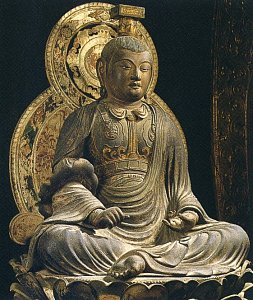
Seated Monju Bosatsu 文殊菩薩 by Jōkei 1.
Dated +1196, Kōfukuji Temple 興福寺, Nara.
Woods, H = 94 cm, National Treasure.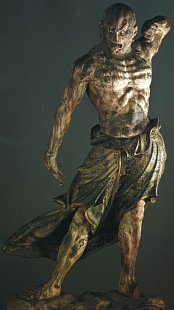
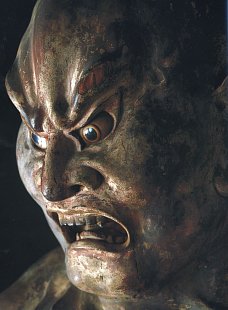
Agyō 阿形 H = 154 cm, aka Kongō Rikishi 金剛力士.
Attributed to Jōkei 1. Wood, with paint applied. Kamakura Era.
Kōfukuji Temple 興福寺, Nara. National Treasure.
See Niō Guardians for details on Agyō.
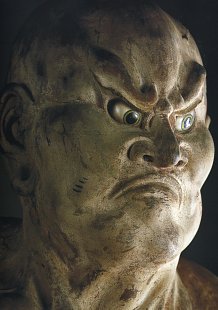
Ungyō 吽形 H = 153.7 cm, aka Kongō Rikishi 金剛力士.
Attributed to Jōkei 1. Wood, with paint practical. Kamakura Era.
Kōfukuji Temple 興福寺, Nara. National Treasure.
Encounter Niō Guardians for details on Ungyō.
![]()
Inkō 院康 (Inko). At Kakuon-ji Temple 覚園寺 in Kamakura, there is a wooden statue of Ashuku Nyorai (see beneath photo), reportedly carved in 1322 AD by a local sculptor named Inkō 院康 (years of birth/death unknown). During the Kamakura Era, in that location were sculptors whose name began with "in," like Inkei and In'no. Inkei fashioned a sedentary statue of Priest Ken'nichi Koho (enshrined at Kencho-ji Temple in Kamakura), while In'no is idea to be the creator of a statue of Priest Sho-in Myogen (enshrined at Engaku-ji Temple, also in Kamakura). Both are considered excellent sculptors of the 14th century, and belong to a school of sculpture called the "In" school. <above paragraph courtesy of Kondo Takahiro>
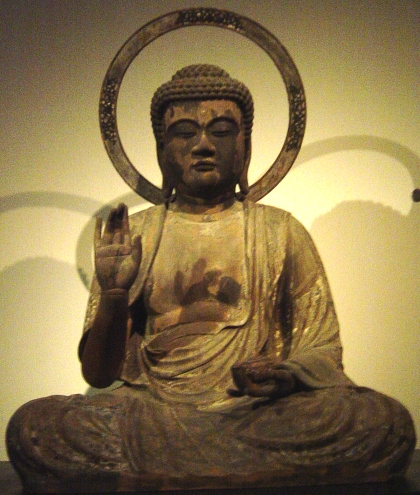
Ashuku Nyorai, Treasure of Kakuon-ji 覚園寺 Temple (Kamakura).
Wood Carving attributed to sculptor Inkō 院康. H = 115 cm (about 3.77 feet).
Dated 1322 Advertising. Deity holding medicine jar in left hand.
The statue of Ashuku Nyorai (run across to a higher place photo) enshrined at Kakuon-ji Temple in Kamakura was originally thought to be Yakushi Nyorai (the Medicine Buddha), for Yakushi is typically shown holding a medicine jar in the left hand. Only at some betoken, the temple priests discovered an inscription subconscious inside the caput of the statue, which gave both the name of the deity (Ashuku) and the artist (Inko 院康) who carved the statue. Still, Yakushi Nyorai is also closely associated with the eastern quarter -- Yakushi is the Lord of the Eastern Pure Country of Lapis-Lazuli, while Ashuku is the Lord of the Eastern Country of Exceeding Great Please. In some traditions, Yakushi and Ashuku are said to inhabit the aforementioned trunk. Ashuku is also 1 of the Five Wisdom Buddha.
![]()

![]() Jōkei 2 定慶 (Jokei)
Jōkei 2 定慶 (Jokei)
A member of the Kei school of Japanese sculpture. Jōkei ii was born in +1184. Curiously, another important sculptor, slightly older, used the same name, then scholars label them every bit Jōkei 1 and Jōkei ii. Jōkei two is credited with creating his own unique style, blending both the realism of the Kei school with the artistic styles of Prc's Sung Dynasty. His work is decidedly "delicate" in comparison to that of Jōkei 1, yet his Niō statues are quite dynamic and powerful. During his life, he rose to Hokkyō rank and received the honorary title Bettō 別当 (workshop director, project manager).
- Shaka Nyorai 釈迦如来, Suzuki Collection (Tokyo), made in +1223
- Bishamonten 毘沙門天, Tokyo Academy of Arts, made in +1224
- Half dozen Manifestations of Kannon Bosatsu 六観音, fabricated in +1224, at Daihō-onji Temple 大報恩寺 (Kyoto). See photos below. Too visit the Kannon page for historical notes on the Six Kannon.
- Shō-Kannon 聖観音, made in +1226, at Kuramadera 鞍馬寺, Kyoto. See photo at right.
- Niō Guardians 仁王, made in +1242, at Sekigan-ji Temple 石龕寺 in Hyōgo Prefecture.
- Niō Guardians 仁王, made in +1256, at Ōzōji Temple 横蔵寺, Gifu Prefecture.
Half dozen Kannon by Jōkei ii
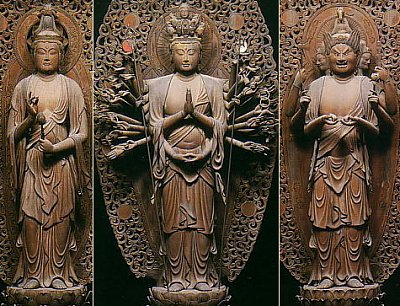
Six Kannon 六観音 by Jōkei 2 定慶, Dated +1224
Wood, Treasures of Daihō-onji Temple 大報恩寺 (Kyoto)
Shō Kannon 聖観音, Senju Kannon 千手観音, Batō Kannon 馬頭観音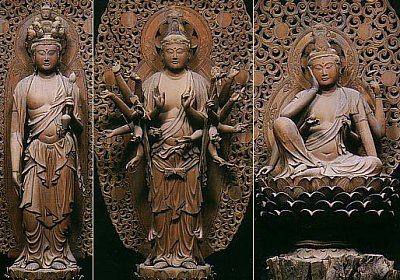
Six Kannon 六観音 past Jōkei 2 定慶, Dated +1224
Wood, Treasures of Daihō-onji Temple 大報恩寺 (Kyoto)
Jūichimen Kannon 十一面観音, Juntei Kannon 准胝観音, Nyoirin Kannon 如意輪観音
See Above Six Photos
Vi Kannon to Protect All Sentient Beings in the Six Realms of Rebirth
6 Kannon 六観音 past Jōkei 2 定慶, Dated +1224, Woods, Daihō-onji Temple 大報恩寺 (Kyoto)
- Beings in Hell, Shō Kannon 聖観音, 177.9 cm
- Hungry Ghosts, Senju (1000-Armed) Kannon 千手観音, 180.0 cm
- Animals, Batō (Horse-Headed) Kannon 馬頭観音, 173.three cm
- Ashura, Jūichimen (xi-Headed) Kannon 十一面観音, 180.6 cm
- Humans, Juntei Kannon 准胝観音, 175.7 cm
- Deva, Nyoirin Kannon 如意輪観音, 96.1 cm
Note One: Run into Six Realms for many more details. Notation Ii: Professor Sherry Fowler (U. of Kansas) has done extensive research on the 6 Kannon of Daihō-onji 大報恩寺. Note Three: Like Japanese groupings of the Six Jizō Bosatsu, the Kannon in Japan is too shown in six basic forms to protect people in all six realms of rebirth (reincarnation). The six forms of Kannon, of Chinese origin, come in at least 3 unlike groupings. The earliest known reference to the six comes from a Chinese Tendai text entitled 摩訶止観 (Jp. = Makashikan; circa 594 AD), translated as "Great Concentration and Insight." Past the early-mid 10th century AD, effigies of the Six Kannon were used in Nihon to pray for the welfare of the expressionless. The half-dozen as well appear ofttimes in the Rokujikyō Mandara 六字経曼荼羅 of Nippon's Shingon sect. (Source JAANUS) Also visit our Kannon page for more historical notes on the Six Kannon.
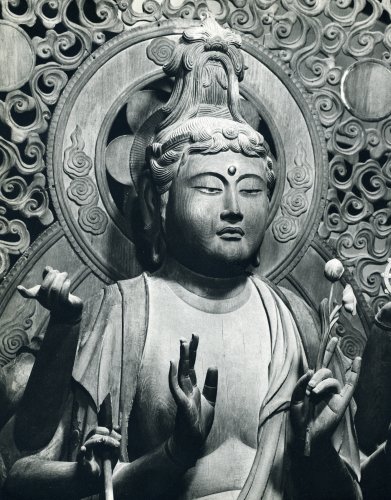
Closeup of Juntei Kannon, one of the Half dozen Kannon, by Jōkei 2
![]()
Kōyū 幸有 (Koyu). Nearly naught is known of this busshi or his lineage. But the powerful and heroic manner of Unkei's Keiha schoolhouse is very apparent. Some other notable feature is the wavy folds in the robe'due south drapery, feature of Song-dynasty artistic tastes. This statue is considered a masterpiece of the Kamakura period. See photo immediately below.
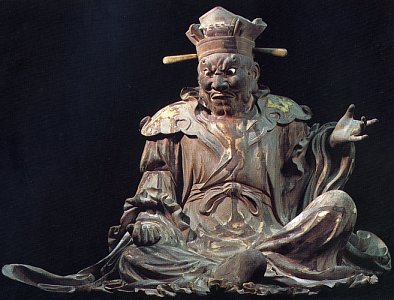
King Shokō-ō 初江王, the 2nd Judge of Hell, past Kōyū 幸有.
H = 100 cm, Forest, Dated +1251, Treasure of Ennō-ji Temple 円応寺.
Now housed at Kamakura Museum (Kamakura Kokuhokan).
![]()
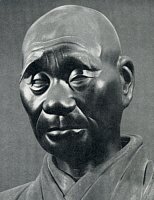
Monk Eison 叡尊 by Zenshun
Dated +1280, Saidaiji Temple
Eison resided at this temple.
Painted wood, H = 89.iv cm
An innovative branch of the Keiha School that emerged in the Kamakura catamenia. Called the ZEN school, for nigh of its artists used the characther ZEN 善 in their names. The term HA 派 literally means schoolhouse or group. It should be noted that the character ZEN 善 in their names is different from the character for Zen 禅 Buddhism. There is no unsaid relationship between the Zenpa artists and the Zen religious sect. The Zenpa school was substantially an offshoot of the Keiha school, and today its artists are classified equally part of the Kei tradition. Agile mainly in the Nara area in the early to mid-Kamakura period (13th century). Its artists displayed a wider range of stylistic variation than did other schools. They were closely connected with Saidaiji Temple 西大寺 in Nara, where they maintained close links with the monk Eison 叡尊 (1201-1290), who gave them many commissions. Zenpa artists were apprenticed according to the traditional workshop system, and the senior position, Daibusshi 大仏師, was passed on by inheritance. When Unkei and other Kei artists moved to Kyoto in the early 13th century, the Zen artists remained in Nara to conduct on the tradition of the Nara Busshi. Of import members include:
- Zen'en 善円 (dates unknown)
Aizen Myō-ō 愛染明王, dated +1247, by Zen'en, under the sponsorship of Monk Eison, at Saidaiji Temple 西大寺, Nara. Zen'en'southward work is noted for technical excellence. Come across photograph below.Shaka Nyorai 釈迦如来, dated +1225, Tōdaiji Temple 東大寺, Nara. Run across photo below.
- Zenkei 善慶 (d. +1258)
Shaka Nyorai 釈迦如来, dated + 1249, Saidaiji Temple 西大寺, Nara. See photo below. Sponsored by Monk Eison. Zenkei'southward work is noted for its delicate sensitivity. Historical records do non reveal if there was any close connexion between Zen'en and Zenkei. Also a statue of Yakushi Nyorai 薬師如来, Shōfukuji Temple 正福寺 (??), Awaji Isle 淡路, Hyōgo Prefecture. - Zenshun 善春 (dates unknown). Son of Zenkei (see in a higher place). His extant works include the portrait statue of Eison 叡尊, made in +1280, at Saidaiji Temple 西大寺, Nara. Run across photos beneath. Also a statue of Prince Shōtoku Taishi 聖徳太子 at Gokuraku-bō Temple 極楽坊 (once part of the at present lost Gangōji Temple 元興寺) in Nara. Zenshun'southward piece of work is noted for its realistic portraiture.
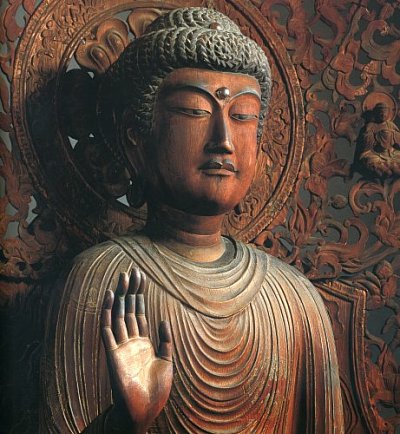
Shaka Nyorai 釈迦如来, by Zenkei, Unpainted wood with gilded leaf patters
H 167 cm. Dated +1249. Saidaiji Temple 西大寺, Nara.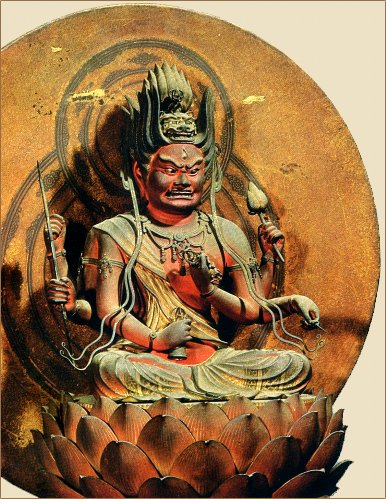
Aizen Myō-ō 愛染明王, by Zen'en, Painted wood. H 42.iv cm. Dated +1247
Aizendō, Saidaiji Temple 西大寺, Nara. Photo courtesy Heibonsha.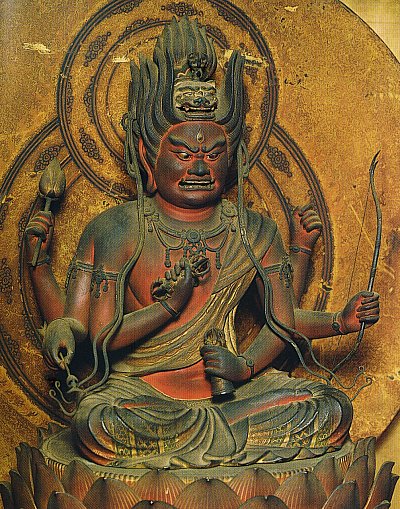
Aizen Myō-ō 愛染明王, by Zen'en
Same statue as prior photo. Photo courtesy 日本の仏像 mag.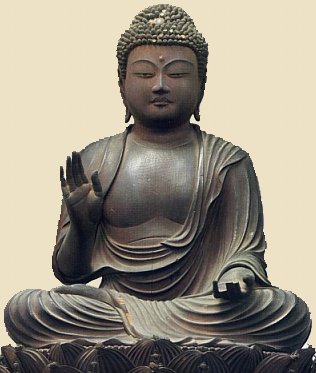
Shaka Nyorai 釈迦如来, dated +1225, by Zen'en
Wood, H = 29 cm, Tōdaiji Temple 東大寺, Nara. Photograph from temple itemize.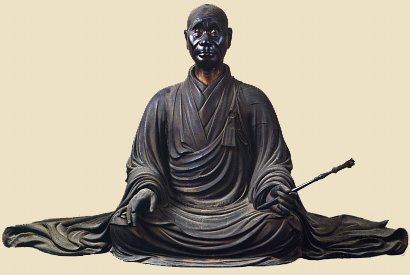
Above and Beneath. Monk Eison 叡尊 by Zenshun.
Dated +1280, Saidaiji Temple 西大寺, Nara
Painted wood, H = 89.four cm. Eison resided at this temple.
Photo courtesy 日本の仏像 mag.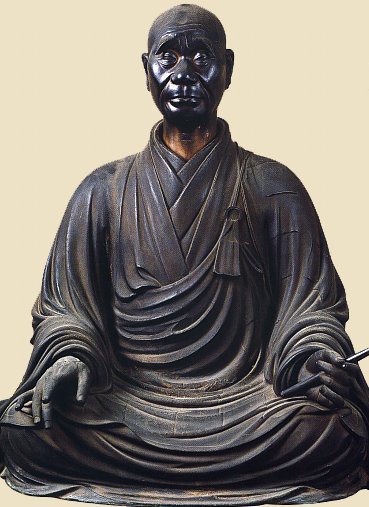
Closeup of above photo.
![]()
NOTEBOOK. Non all the same incorporated into site page.
Below text courtesy JAANUS. Chinsou 頂相. Alt. reading chinzou. Lit. caput's appearance. A naturalistic portrait, sculpted or painted, of a Zen 禅 master'southward head. Chinsou can be divided into two types depending on their function. First are inka 印可, given by a main to his disciple as a certificate of the pupil's attainment of spiritual sensation and every bit a symbol of the articulate and unbroken lineage of a sect. These portraits often include hougo 法語, or words of religious enlightenment, inscribed by the priest depicted. A portrait done in a realistic and detailed style, together with an inscription, provided the disciple with both the tangible presence and the inspiration of the teaching of his chief long after personal relations were severed through parting or expiry. Second are keshin 掛真 which were to exist hung or placed together with imaginary portraits of Zen patriarchs *zenshuu soshizou 禅宗祖師像 in either the Dharma Hall *hattou 法堂, or master gate *sanmon 三門, of Zen sect temples in connexion with memorial services. Chinsou of this 2nd blazon were made after the chief'due south decease and the inscription was normally added past a close contemporary. Chinsou sculpture belongs entirely to the keshin category. The desire to symbolize the personal relationship between sitter and disciple recipient, or to memorialize a chief for later followers, necessitated a high degree of verisimilitude. Moreover, the chinsou creative person was encouraged to go beyond the mere concrete likeness to capture something of the inner spirit of his field of study. Painted chinsou are known in iii formats. The about orthodox blazon show the priest wearing his full robe noue 衲衣 and surplice kesa 袈裟, seated en face in a large upholstered wooden armchair *kyokuroku 曲ろく, holding a bamboo baton shippei 竹箆 or whip kyousaku 警策 in the correct hand. He is often shown with legs tucked under and shoes on a small footrest kutsudoko 沓床. A second format which evolved after was the one-half-length or bust portrait hanshinzou 半身像 that focuses on the individualistic details of the confront. Typically in such depictions, even the easily of the priest volition be hidden beneath the voluminous sleeves except for the exposed thumb of the left-hand. Orthodox painted chinsou feature a naturalistic style with fine linear details and a full range of colors, although some later examples are rendered more simply in ink monochrome. The third category may be termed special formats, including portraits of a master walking or resting *kinhinzou 経行像 and commonly including mural elements, as well as bosom portraits in a circular framework *ensouzou 円相像. The chinsou tradition is said to have begun in China, mayhap initiated past the needs of Japanese students. In the late 12c when Japanese priests returned from study in China, they often brought chinsou of their Chinese masters. A representative early case is the bearding 1238 portrait of Bujun Shiban 無準師範 (Alt.reading Mujun Shihan, Ch: Wuqun Shifan) presented to the Japanese priest Bennen Enni 弁円円爾 (1202-80), who on his render founded Toufukuji 東福寺. Initially Japanese Zen temples lacked the artists to produce chinsou and therefore employed portrait specialists from other sects. A good example is the 1265 portrait of Gottan Funei 兀庵普寧 (Ch: Wuan Puning, 1197-1276) by Takuma Chouga 託磨長賀, priest-painter of the esoteric temple Shoudenji 正伝寺. Early chinsou are unsigned, a fact that has profoundly complicated the event of determining the artist and even country of origin. Perhaps the earliest signed chinsou by a Japanese painter priest of a Zen sect is the portrait of Muhon Kakushin 無本覚心 by Kakue 覚恵 (Koukokuji 興国寺). By the mid 14c, Japanese artists were producing high quality chinsou equally demonstrated by the bearding 1334 portrait of Daitou Kokushi 大燈国師 (Daitokuji 大徳寺) and the 1349 portrait of Musou Kokushi 夢窓国師 by his desciple Mutou Shuui 無等周位 (Tenryuuji 天竜寺). From the late 14c painter-priests such as Minchou 明兆 (1351-1431) produced large numbers of excellent chinsou at the ateliers of major Zen temples. The creative vigor of the chinsou tradition connected in the 15c, exemplified by the remarkable portrait of *Ikkyuu 一休 (Daitokuji 大徳寺) attributed to his disciple Bokusai 墨斎 (?-1492). Chinsou were produced throughout the Edo menses, with the portraits of the Oubaku 黄檗 (Ch: Huanglo) sect of special annotation. <end JAANUS quote>
![]()
Resources
- JAANUS. Japanese Architecture & Art Net Users Organisation. Online database devoted to Japanese fine art history. Compiled by the late Dr. Mary Neighbour Parent, it covers both Buddhist and Shintō deities in great item and contains over eight,000 entries.
- Dr. Gabi Greve. See her page on Japanese Busshi. Gabi-san did nearly of the enquiry and writing for the Edo Period through the Mod era. She is a regular site contributor, and maintains numerous informative web sites on topics from Haiku to Daruma. Many thanks Gabi-san !!!!
- Heibonsha, Sculpture of the Kamakura Period. By Hisashi Mori, from the Heibonsha Survey of Japanese Art. Published jointly by Heibonsha (Tokyo) & John Weatherhill Inc. A volume close to my heart, this publication devotes much time to the artists who created the sculptural treasures of the Kamakura era, including Unkei, Tankei, Kōkei, Kaikei, and many more than. Highly recommended. 1st Edition 1974. ISBN 0-8348-1017-4. Buy at Amazon
.
- Archetype Buddhist Sculpture: The Tempyo Menstruum. By author Jiro Sugiyama, translated by Samuel Crowell Morse. Published in 1982 by Kodansha International. 230 pages and 170 photos. English text devoted to Japan'due south Asuka through Early Heian periods and the evolution of Buddhist sculpture during that fourth dimension. ISBN-ten: 0870115294. Buy at Amazon.
- The Swell Historic period of Japanese Buddhist Sculpture, AD 600-1300. By Nishikawa Kyotaro and Emily J Sano, Kimbell Art Museum (Fort Worth) and Nippon Business firm Gallery, 1982. 50+ photos and a wonderfully written overview of each period. Includes handy section on techniques used to make the statues. The Not bad Age of Japanese Buddhist Sculpture (Advertisement 300 - 1300)
.
- Comprehensive Lexicon of Nippon's National Treasures. 国宝大事典 (西川 杏太郎). Published past Kodansha Ltd. 1985. 404 pages, hardcover, over 300 photos, mostly colour, many full-page spreads. Japanese Language Simply. ISBN 4-06-187822-0.
- Bosatsu on Clouds, Byōdō-in Temple. Catalog, May 2000. Published by Byōdō-in Temple. Produced by Askaen Inc. and Nissha Printing Co. Ltd. 56 pages, Japanese language (with modest English language essay). Over fifty photos, both colour, B&Westward. Some photos at this site were scanned from this volume. Of item employ when studying the life and work of Jōchō Busshi.
- Visions of the Pure Country: Treasures of Byōdō-in Temple. Catalog, 2000. Published past Asahi Shimbun. Artwork from Byōdō-in Temple. 228 pages, Japanese language with English language index of works. Over 100 photos, color and B&W. Some photos at this site were scanned from this volume. No longer in print. Of particular use when studying the life and work of Jōchō Busshi.
- Numerous Japanese-linguistic communication temple and museum catalogs, magazines, books, and web sites. See Japanese Bibliography for extended list. Also relied on Hōryūji Temple 法隆寺 (Horyuji) catalogs and Asuka Historical Museum.
![]()

![]() JAPANESE WEB SITES
JAPANESE WEB SITES
- Bunkaken.cyberspace. Busshi & Deity Reviews. Also see lineage chart.
- Site by Yard. Katada with Keiha lineage nautical chart.
- Nihon'due south National Treasures and Busshi Information.
- Inpa, Enpa, and Keiha Lineage Charts.
- Kyoto Busshi past Period from Encyclopedia of Kyoto.
- Hidden Buddha, Walking Around Kyoto Monthly Magazine.
- Another Lineage Chart (npo.butuzou.net).
- Important Busshi and Lineage Chart.
- Japanese Postal Stamps of Buddhist Deities (for fun)
![]()
Source: https://www.onmarkproductions.com/html/busshi-buddha-sculptors-kamakura-era-japan.html
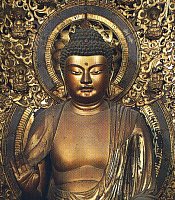
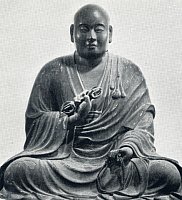
0 Response to "The Kei School of Sculpture Occurs During Which Period of Japanese Art History?"
Post a Comment